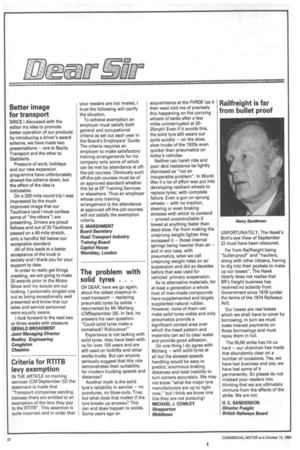The problem with solid tyres . . .
Page 24

If you've noticed an error in this article please click here to report it so we can fix it.
OH DEAR, here we go again, about the oldest chestnut in road transport — replacing pneumatic tyres by solids — resurrected by Mr McHarg (CMSeptember 29). In fact, he answers his own question: "Could solid tyres make a comeback? Ridiculous!"
Experience is not lacking with solid tyres: they have been with us for over 100 years and are still used on forklifts and other works trucks. But can anyone seriously suggest that this role demonstrates their suitability for modern trucking speeds and distances?
Another myth is the solid tyre's reliability in service — no punctures, no blow-outs. True, but what does that matter if the tyre breaks up anyway? This can and does happen to solids. Some years ago an acquaintance at the FVRDE (as it then was) told me of precisely this happening on the carrying wheels of tanks after a few miles uninterrupted at 2025mph I Even if it avoids this, the solid tyre still wears out quite quickly — on the slow, slow trucks of the 1920s even quicker than pneumatics on today's vehicles.
Neither can harsh ride and poor skid resistance be lightly dismissed as "not an insuperable problem". In World War II a lot of effort was put into developing resilient wheels to replace tyres; with complete failure. Even a gun on sprung wheels — with no traction, steering or even braking stresses with which to contend — proved uncontrollable if towed at anything faster than dead slow. Far from making the unsprung weight lighter they increased it — those internal springs being heavier than air — and in any case, with pneumatics, what we call unsprung weight rides on air suspension and did so decades before that was used for vehicles' primary suspension.
As to alternative materials, for at least a generation a whole host of man-made compounds have supplemented and largely supplanted natural rubber. However, none of them can make solid tyres viable and only pneumatics provide a significant contact area over which the tread pattern and materials can act to clear water and provide good adhesion.
On one thing I do agree with McHarg — with solid tyres at all but the slowest speeds handling would be easy to predict; enormous braking distances and total inability to turn corners accurately. We may not know "what the major tyre manufacturers are up to right now," but I think we know one line they are not pursuing! MICHAEL J. COWLEY Shepperton Middlesex
















































































































































